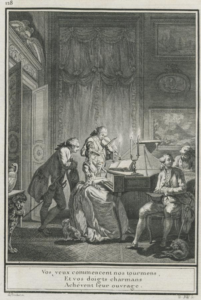This Australian Research Council Discovery Project is a cross-institutional collaboration between ANU (Glenn Roe and Robert Wellington), The University of Melbourne (Erin Helyard), The University of Sydney (Mark Ledbury), and Oxford University (Nicholas Cronk). Through the study of a unique and ambitious eighteenth-century songbook – Jean-Benjamin de Laborde’s Choix de Chansons (1773) – our project provides a workable solution to these questions by way of the notion of ‘transdisciplinarity’. First described by the developmental psychologist and philosopher Jean Piaget as a superior stage of interdisciplinary relationships, the transdisciplinary approach implies a total system of interrelated knowledge without established disciplinary boundaries; a system that has much in common with that imagined by Diderot and d’Alembert in the Encyclopédie. We propose that the Choix de Chansons is also in many ways a quintessential transdisciplinary object. As such, it requires a new methodological approach that operates at the interface of interdisciplinary collaboration, rich historical contextualization, and new media dissemination.
This is the first project of its kind to address the complex transdisciplinary and transmedial nature of both Laborde’s Choix de Chansons, and of eighteenth-century print culture more generally. The complementary disciplines of musicology, art history, and French literature will create a unique transdisciplinary matrix in which our team will ‘perform’ Laborde’s text in order to recreate its original modes of reception, evoking the ways eighteenth-century participants appreciated, decoded, and debated the intersections of music, visual art, and literature.
Most often, this kind of cultural consumption was enacted publicly and sensationally at the opera. But, unlike such multimedia events, and based on the quasi-democratic principles of Masonic culture, Laborde’s text is meant for a small community of like-minded individuals who commingle their performative experiences in the intimacy of a salon around a single instrument: harp or harpsichord. In many respects, Laborde’s project aims to reproduce – albeit, in miniature – the operatic experience by simulating the close connections between image, music and text. The novel aspect in Laborde’s scenarios is that these connections take place not in the public arena of the opera box, where spectators perform only as audience members, but rather in the chamber, where the participants are no longer merely spectators but themselves performers.
This emphasis on individual expression as a meaningful component of a close engagement with others in a culture of sociability and sensibilité echoes the contemporaneous musical, philosophical and social trends. By implication, any attempt at recapturing the creative, receptive, and performative complexity of Laborde’s songbook – or any other complex cultural artefact for that matter – today requires new models of cross-disciplinary collaboration and multimedia dissemination. Our project will provide one such model, aimed at reproducing digitally the cultural context of the Chansons, both as an object of transdisciplinary communication – one that actively speaks from the nexus of image music, and text – and as a product of the cultural and intellectual networks of the time, from courtly and salon culture to the more progressive sociability of the Masonic societies.
By moving the Chansons from print to digital media we can not only incorporate multiple layers of remediation (image, music, text), but also shed greater light on the various strata – social, intellectual, political, philosophical – that informed the work’s production and its relationship to the cultural networks mentioned above. We will develop a new digital edition of the Chansons that will present high-resolution scans of its pages and engravings alongside transcriptions of the poetry and recordings of the songs. This juxtaposition will expose the image-music-text relationship inherent to the illustrated songbook.
text by Glenn Roe, Erin Helyard, Mark Ledbury, and Robert Wellington.
Related conference presentations:
“Performing Transdisciplinarity: Image, Music, and Text in Eighteenth-Century Print Culture” (with Robert Wellington) in Digital Approaches in the Study of Early Modern Culture, ANU, Canberra, November 2015; and Recasting the Question: Digital Approaches in Art History and Museums, The University of Sydney, November 2015.





Pingback: Voltaire Foundation appoints Digital Research Fellow | Voltaire Foundation